

| Home | Log In | Register | Our Services | My Account | Contact | Help |
You are NOT currently logged in
dai oldenrich - 01 Sep 2006 13:32
click your browser refresh button to update charts
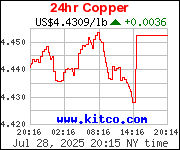
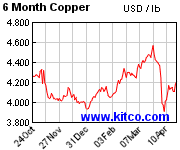
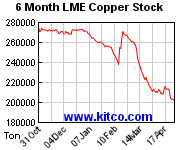
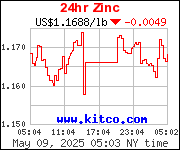
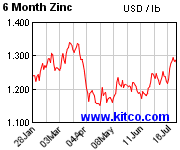
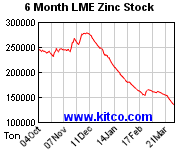
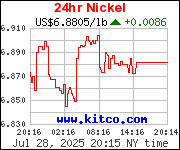
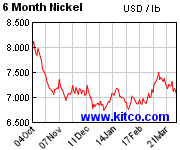
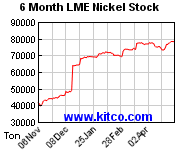
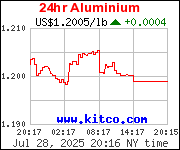
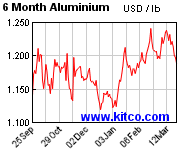
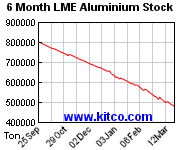
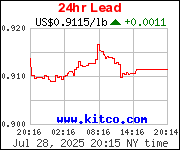
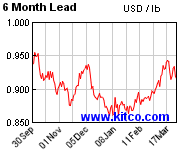
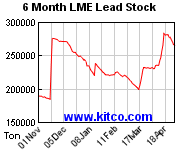
Also see: gold charts here silver charts here platinum charts here
dai oldenrich - 02 Sep 2006 08:03 - 5 of 181
Copper Falls in London as Chile Strike and Metals Demand Slows
By Katy Watson and Millie Munshi
Sept. 1 (Bloomberg) -- Copper prices fell in London after workers at the world's largest copper mine ended a strike and a U.S. report showed construction spending declined the most in five years.
BHP Billiton Ltd. miners will return to work tomorrow, company spokeswoman Alejandra Wood said, paving the way for higher output. Builders, the biggest U.S. users of the metal, spent 1.2 percent less in July, the Commerce Department reported today. Prices are up 73 percent in London this year, partly from surging construction demand.
Copper was ``way above what it should be, partly on the risk that the strike would have gone on longer than it has,'' said Helen Henton, head of commodity research at Standard Chartered Plc in London.
Copper for delivery in three months dropped $90, or 1.2 percent, to $7,610 a metric ton at 7 p.m. on the London Metal Exchange. Before today, the metal dropped 3 percent since the strike began Aug. 7 as inventories jumped 22 percent and government reports showed the U.S. housing market slowed.
Copper futures for December delivery were little changed, up 0.5 cent at $3.461 a pound on the Comex division of the New York Mercantile Exchange. Prices that have more than doubled in the past year are down 14 percent since reaching a record $4.04 on May 11.
High costs for the metal, used in wire and pipe, may be hampering demand, said Jay Richman, owner of E.W. Berger & Brother Inc., a wholesale plumbing supplier in Weehawken, New Jersey.
Seeking Alternatives
Consumers are turning to alternatives such pipes made from plastic instead of copper, said Richman, who purchases about 10,000 pounds of copper a month for redistribution to plumbers, housing authorities and other industrial users.
``Unless copper prices drop, more and more people in our industry are going to be using plastic,'' he said. ``No one's buying enough copper.''
Growth in U.S. manufacturing also eased in August to a pace that's consistent with the recent cooling in the economy. The Institute for Supply Management's manufacturing index declined to 54.5 from 54.7 in July. A reading higher than 50 signals expansion.
``Slowing economies certainly threaten industrial metal demand,'' said Jimmy Quinn, a trader at A.G. Edwards Inc. in New York. ``If we hear any kind of hawkish tone'' from the Federal Reserve or other central banks, ``that could continue to slow the economy and hurt'' copper demand, he said.
European Slowdown
European manufacturing growth slowed more than expected in August as higher oil prices and a stronger euro cooled economic expansion.
Royal Bank of Scotland Plc said today its index compiled by NTC Economics Ltd. declined to 56.5 from July's 57.4. A reading above 50 indicates European expansion and the gauge, based on a survey of 3,000 purchasing managers, has been above that level since June 2005. The median forecast of 36 economists surveyed by Bloomberg News was for a decline to 57.
The drop in the index may indicate that the pace of economic growth is set to turn lower after it reached its fastest in six years in the second quarter. Investor confidence in Germany, the largest European economy, dropped to a five-year low in August, the Ifo institute said last week.
``The data is showing the rate of growth will decelerate this year,'' said Jim Lennon, a metals analyst at Macquarie Bank Ltd. in London.
The end of the strike at Escondida probably will send copper lower next week, snapping a two-week rally, a survey by Bloomberg News showed.
Copper Survey
Seven of 13 analysts, investors, traders and consumers surveyed yesterday and on Aug. 30 forecast copper will decline. Five expected a gain and one projected little change.
Still, funds may buy copper and other industrial metals in the fourth quarter of 2006.
``There potentially could be a new wave of index-fund money coming in, in the fourth quarter,'' Macquarie Bank's Lennon said.
Nickel for delivery in three months dropped $250, or 0.9 percent, to $28,550 a ton in London. Inventories monitored by the LME gained 186 tons, or 3.6 percent, to $5,358 tons. Still, stockpiles have plunged 85 percent this year.
Prices in the long term may fall by half from current levels as more mine production increases world supplies, David Brown, chief executive officer of Impala Platinum Holdings Ltd., said in an Aug. 30 interview. He declined to be more specific on when prices will fall.
The metal, used as an alloy in stainless steel production, jumped to $29,950 a ton Aug. 22, the highest since at least 1987. Prices have doubled this year amid declining stockpiles.
``Nickel pricing will stay quite firm in the short term, trending down as supply increases,'' Brown said. ``It will be closer to half of that in the long term.''
Impala owns the world's biggest platinum mine, which is in South Africa. Nickel is produced as a byproduct of platinum mining.
dai oldenrich - 02 Sep 2006 08:05 - 6 of 181
The Guardian - Saturday September 2, 2006 - Fiona Walsh
Copper price slides after Chilean strike settlement
The pay settlement at the huge Escondida mine, Chile, saw copper slide yesterday, although traders said the price will continue to be supported in the short-term by the prospect of contract negotiations at other mines.
After Thursday's 3% jump, the price of copper for three-month delivery slipped from $7,700 to $7,595 a tonne in London yesterday, although dealers said trading was thin ahead of the Labor Day holiday in the US.
The strike at Escondida, which is owned by BHP Billiton and Rio Tinto, lasted for four weeks. Full production is expected to be restored within a week.
dai oldenrich - 03 Sep 2006 08:03 - 7 of 181
Parallels Between Stockmarket in 2000 vs Commodity Market of Today
By John Lee - (www.maucapital.com)
As we predicted in a July market update to our clients, on August 8th the U.S Federal Reserve left interest rates untouched. The pause ended the streak of seventeen straight interest rate hikes that began in June of 2004. The Fed funds rate, which was at a forty-six year low of 1% at the start of the rate hike campaign, is now at 5.25%.
The Fed justified the pause by stating: Economic growth has moderated from its quite strong pace earlier this year. It also implicated a gradual cooling of the housing market and the lagged effects of increases in interest rates and energy prices as factors slowing growth.
These statements make it seem like the Fed is calling the shots, however, with the real estate market slowing down, consumer loan rates precariously high, and a sagging stock market the Fed had no choice but to pause.
How will the pause affect the precious metals and equity markets? History might provide some insights here.

Interest Rates 1996 2001:
In 1996, the Fed Chairman Alan Greenspan claimed that the U.S economy was suffering from irrational exuberance in the stock market. In other words, too much money was being piled into the booming technology and internet sectors.
For a few months, the speech created a short lived downturn in the equity markets. Nonetheless, after issuing the warning Greenspan didnt touch interest rates and the S&P 500 continued to soar.
Beginning in October of 1998, two years after Greenspans infamous speech the S&P 500 exploded; rising from about 1000 to over 1400 by July of 1999. The Fed reacted to this 40% increase in the S&P 500 by hiking interest rates from 4.75% in June of 1999 to 6.5% in June of 2000.

Three months after the interest rate was lifted to 6.5%, the S&P 500 started to crash. The Fed had apparently overshot the interest rate and after a brief lag the S&P began to decline.
In reaction to the onset of the crash, the Fed reversed course and began a series of interest rates cuts in January of 2001. Nonetheless, the S&P 500 continued to decline and the Fed continued to cut interest rates. By June of 2002 interest rates were dropped to a historic low of 1%; yet this accommodative policy didnt seem to help S&P 500, which dropped 47%.
In April of 2003, five months after the Fed interest rate reached 1%, the bottom for the S&P 500 was established. Again, there was a lag between the conclusion of a series of Federal interest rates moves and the moves in the equity markets.
Since April of 2003, the S&P 500 is up more than 50% and has been rising almost non-stop. The un-naturally low 1% interest rate (negative real interest rate) created by the Fed in 2003 spurred a boom in equity and commodity markets. In turn, the rise in commodities was the driver behind the latest interest rate hike campaign that started in 2004.
Interest Rates 2004-2006:
Since June of 2004, in response to rising oil and commodity prices, the interest rate has been increased seventeen times and it currently stands at 5.25%. Like the stock market in 1999, which didnt react to the Feds tightening policy until months later, commodity prices have failed to respond to the recent rate hikes designed to dampen inflation. In fact, oil has risen from $22 a barrel in 2003 to over $70 a barrel today.

After all these rate increases, the Fed now has its hands tied behind its back. On the one hand, the Fed is still dealing with the pressures of rising commodity prices. On the other, the economy is increasingly showing signs that it is slowing down.
Its uncertain at this time whether rates are now high enough to clamp down commodity prices. A $100 a barrel oil price could force the Fed to tighten further. However, taking history as a guide, the Fed tends to overshoot on interest moves and equity and commodity markets usually react after a period of lag.
It is possible that the Fed has already overshot rates again. If this is the case, history shows us that the equities markets may begin to buckle within the next three to six months. Such an outcome could prompt the Fed to possibly ease rates by early next year.
How will the current interest rate situation affect the precious metals?
The pause signals a new era for the precious metals. Since 2004, gold and silver have been rising in tandem with rising interest rates. It remains to be seen whether the precious metals will continue to rise independent of interest rate hikes.
In April, Newmonts President Pierre Lassonde predicted that the $850 gold price of the 1980s could be challenged within 18 months. August and September will be critical in determining the future for the precious metals. If gold can hold above its 200 day moving average of $580, it will strengthen Lassondes case for a robust metals market for the next 6-9 months.
As the markets take the time to adjust to the Feds interest rate policy, metals investors must become more macro-aware and keep a close eye on the U.S equity markets as well as the metals markets.
John Lee, CFA
HARRYCAT
 - 03 Sep 2006 11:38
- 8 of 181
- 03 Sep 2006 11:38
- 8 of 181
Thanks daiO.
Platinum is my particular interest. Diesel catalytic converters etc.
Very useful.
Platinum is my particular interest. Diesel catalytic converters etc.
Very useful.
dai oldenrich - 04 Sep 2006 07:20 - 9 of 181
Times - Ambrose Evans-Pritchard - (Filed: 04/09/2006)
Monday view: Even the sophisticated are attracted by lure of autumn gold
Gold almost always rises in the autumn, sometimes a little, lately by leaps and bounds. Even when it churned ever-down from a peak of $850 an ounce in 1980 to $255 in March 2001, it usually managed to eke out a meagre counter-rally each September.
The seasonal cycle is anchored in the ancient habits of the Orient, where buying picks up after the Indian monsoon and reaches a climax with the Chinese New Year.
Speculators have noticed this, of course, so it has become self-fulfilling. Hedge funds programme their black boxes with triggers to catch the anticipated rally, giving the seasonal effect ever-more leverage.
Be careful, however. Gold tends to catch a nasty cold in mid-October before resuming its upwards march towards a New Year peak.
Gold took a battering in May, crashing 26pc from its quarter-century high of $730. It was scary for newcomers but not enough to reverse the five-year bull market. Gold bounced straight off the crucial 200-day moving average watched by chartists and is now forming a base around $620 technically undamaged.
Goldcorp's chief Ian Telfer predicts a surge to over $800 an ounce over the next two years, though perhaps he would say that to justify the outlandish premium offered in last week's $8.6bn bid for rival Glamis.
Yet there are sophisticated investors that seem to agree. UBS has seen growing demand for gold "call options" dated December 2006 at strike prices of over $1,000, and up to $2,500 by late 2007. The options expire worthless if the price falls short.
John Reade, UBS's precious metals strategist, said gold may churn sideways until a deadline passes on September 26 for European central banks to sell their annual quota of 500 tonnes.
"There is a lot of talk about selling, and where there is smoke there may be fire. But it will be a bullish signal if they fail to take up their quota," he said.
"We think gold could go up a lot this quarter if the dollar starts to fall fast," he said.
So far, the banks have sold just 340 tonnes, chiefly because the Bundesbank has clung to its bullion. "It's not a good idea to touch the stuff. Gold is an important factor for confidence in the euro," said Buba chief Axel Weber.
Quietly, Moscow is buying and Russia's foreign reserves ($258bn and rising at $12bn a month) will soon match those of the entire euro-zone.
And yet, and yet, I fret about those black clouds gathering over the United States, threatening to douse the world commodity boom with an icy downpour.
The resources cycle has been correlated for half a century with US monetary policy, peaking as the Fed Funds Rate peaks. That bell rang in July.
There can no longer be much doubt that the US housing market is crumbling. New home sales fell 21.6pc in July from a year earlier and average prices are following, down from $250,000 in February to $230,000 in July.
What will happen to the global economy when Americans stop drawing $600bn a year in pocket money from home equity, or when $2,700bn of floating rate mortgages come up for adjustment at much higher interest rates?
Gold will soon have to make up its mind whether it is a commodity like the rest of them or whether it is a safe-haven "currency" that shines in bad times a sort of AC/DC asset to hedge against both inflation and deflation.
The jury is still out on that big question. Gold passed the test in the dotcom recession when it parted company with its base cousins in the spring of 2001, pushing upwards as the Goldman Sachs index of industrial metals fell off a cliff. But it failed in the US recessions of 1975 and 1991, holding hands with copper and zinc all the way down.
Contrary to belief, gold is not always a good hedge against trouble. It fell during the French Revolution, again during the Napoleonic Wars, and in the First World War. But then it was the world's currency. Now it is the counter-currency, waiting in the wings to challenge an ever-more deformed and fragile dollar system.
I suspect that gold was already starting to explore this new role in 2001.
Which is not to say that the dollar will crash. It ought to fall, perhaps, to correct the world's vast imbalances but it cannot easily do so because there is no credible currency for it to fall against except gold.
America has only just started to slow, yet Japan is already showing ominous signs of stalling yet again with vehicle sales down 5.9pc in August and construction orders down 20.1pc.
China remains a small economy (one ninth of US consumption), over-dependent on exports for 35pc of GDP.
The eurozone's short-lived expansion has already peaked, with German retail sales dropping 1.5pc in July. Lehman Brothers is predicting an outright recession early next year.
Paris and Berlin both insist that the euro must not rise above $1.30. Should it do so, we can expect finance ministers to start threatening use of their Maastricht powers to dictate exchange policy to the European Central Bank.
No, the dollar cannot collapse because the Japanese and European governments will not let it happen, while the Chinese yuan is pegged in any case.
They will counter US devaluation with devaluation of their own, setting off a fresh cycle of negative real interest rates. Is that what gold is sniffing as a few very rich men and women buy their call options at $2,500 an ounce?
dai oldenrich - 04 Sep 2006 07:32 - 10 of 181
report BEIJING (XFN-ASIA) - 04 september 2006
BHP settlement at Chile's Escondida may raise other mines' labor costs - - The labor settlement at BHP Billiton's Escondida copper mine has made its workers the best paid in Chile and may raise costs at competitors' mines in the country, the Financial Times reported.
The report said Xstrata, Falconbridge, Antofagasta and Anglo American may be affected by the Escondida settlement but the most imminent impact could be on Codelco, which has pay negotiations by the end of the year at units Codelco Norte and Andina.
It said the Escondida salary hike was 8 pct with a cash bonus of 17,000 usd, putting pressure on Codelco, which has some of the lowest paid workers in Chile
"I think Codelco will be very worried about the increases at Escondida, because the unions will see that they are already paid less than other mine workers and they will want to narrow the gap," the FT quoted one person familiar with Codelco as saying.
The FT said Antofagasta will start renegotiating wages at its largest mine, Los Pelambres, in September next year, and at its smaller mines, El Tesoro and Michilla, in 2009 and late 2007.
Anglo American said there has been no significant industrial action at its copper mines in Chile for several years.
dai oldenrich - 04 Sep 2006 15:30 - 11 of 181
Copper Rises in Shanghai on Concern Supply Won't Meet Demand
By Feiwen Rong
Sept. 4 (Bloomberg) -- Copper in Shanghai rose for a second day on concern stocks of the metal held in Chinese warehouses may not be enough to meet demand.
Cash prices for the metal in Shanghai are commanding a premium over futures, an indication supply of the metal isn't meeting demand as the peak consumption season begins, said Li Rong, an analyst at Great Wall Futures Co. in Shanghai. Copper stockpiles fell to the lowest in two months last week.
``The strength in copper prices is mainly because of tight supply in China now,'' Li said. ``Stockpiles in Shanghai Futures Exchange were down by 12 percent in two weeks.''
Copper for October delivery on the Shanghai bourse rose as much as 1,140 yuan, or 1.7 percent, to 70,440 ($8,866) yuan a metric ton. The metal closed at 70,270 yuan a ton at the 11:30 a.m. break.
Copper for immediate delivery in Changjiang, Shanghai's biggest spot market, rose as much as 1.2 percent today to 71,100 yuan a ton. Futures for September delivery closed the morning session at 71,000 yuan a metric ton.
Deliverable stockpiles fell 1,424 tons to 48,193 tons in the week ended Sept. 1, based on a survey of six registered warehouses in the Shanghai Futures Exchange, the exchange said on its Web site.
September is usually the beginning of the peak copper consumption season, Li said.
Growing Economy
Chinese buyers reduced copper imports this year after the metal's price soared to a record $8,800 a ton in May. The nation imported 477,220 tons of copper during January-July, 42 percent less than a year earlier, according to data released by the China Customs General Administration Aug. 25.
July copper production dropped 3.8 percent to 236,000 tons from June, as concentrate imports fell 9.8 percent, according to calculations made by Bloomberg News on customs figures.
China, the world's largest user of copper, raised its estimate for growth in gross domestic product to 2005 to 10.2 percent from 9.9 percent, showing the fastest-growing major economy expanded at the quickest pace since 1995, the National Bureau of Statistics said Aug. 30. It was the third straight year of at least 10 percent expansion for the world's fourth- largest economy.
``The numbers highlight the remarkable stability of growth over this period,'' commodities analysts at Macquarie Bank Ltd. said in a report Sept. 1.
Copper for December delivery gained 2.9 cents, or 0.8 percent, to $3.49 a pound in after-hours trade on the Comex division of the New York Mercantile Exchange at 12:30 p.m. Shanghai time.
Copper for three-month delivery rose $92, or 1.2 percent, to $7,682 a ton on the London Metal Exchange at 12:23 p.m. Shanghai time.
dai oldenrich - 04 Sep 2006 22:19 - 12 of 181
Mon Sep 4, 2006
4-Nickel tumbles 4 percent by end of LME trading
By Anna Stablum
LONDON, Sept 4 (Reuters) - Nickel prices took a severe beating in late trade at the London Metal Exchange on Monday, falling over $1,000 from Friday's kerb close.
Three-months futures ended Monday's kerb at $27,600 per tonne, down $1,100, or 3.8 percent. Once selling began, the metal slipped into free-fall, traders said.
"It was around $28,500, then on the next trade -- which was half an hour later -- it had gone down $300, then another $300." Volumes were tiny and support practically non-existent.
"It was trading one lot, then two lots, then one. There was a void underneath it," the trader said.
Sellers may have been anticipating a large rise in stocks when figures are released at 0800 GMT on Tuesday, he said.
Earlier, traders had said that the longer nickel failed to break resistance at $30,000, the likelier it was to fall.
Nickel hit a record high of $29,250 on August 22, supported by low visible stock levels, and strong demand from stainless steelmakers.
Nickel's backwardation, the premium for cash settlement over three-month delivery, eased to around $2,200 per tonne from $3,400 on Friday.
None of the other LME metals were as active.
Copper prices rebounded slightly as demand was expected to pick up after the European summer holidays, but trading was light on Monday with U.S. markets closed for Labor Day, dealers said.
Copper for delivery in three months ended the kerb at $7,650 versus $7,590 on Friday.
The market had been buoyed by the apparent return of Chinese buyers to the physical market, a Macquarie report said.
"The market mood feels more and more bullish as the seasonally-stronger demand period approaches," it said.
Also, funds tended to allocate fresh money at the start of each month and looming supply disruptions supported sentiment.
"These factors will continue to underpin copper prices for the remainder of the year and, as such, we expect a strong fourth quarter for the red metal," a Standard Bank report said.
As a result, it raised its 2006 cash price forecast to $6,725 from an earlier forecast of $6,600.
MINING STOCKS
Director John Meyer at Numis Securities said the mining sector looked set for further gains after the sell-off in May that took at least 15 to 20 percent off values.
"A generally more positive outlook for equity markets, combined with increasing earnings potential across the mining sector should continue to attract interest," he said in a note.
Three months aluminium ended the day at $2,489, down $1. Zinc was at $3,470, up $30.
Tin was at $9,050, up $150 from its close on August 31, while lead ended the kerb at $1,257, up from $1,225 on Friday.
dai oldenrich - 05 Sep 2006 07:27 - 13 of 181
Copper in Shanghai Rises to Seven-Week High Amid Supply Concern
By Chia-Peck Wong
Sept. 5 (Bloomberg) -- Copper futures in Shanghai rose to their highest in seven weeks amid concerns that stockpiles held in Chinese warehouses may not be able to meet demand.
Copper in London, the world's biggest metals market, soared to a record in May, leading Chinese users to cut imports and rely on domestic stockpiles. Inventories monitored by the Shanghai Futures Exchange fell 17 percent this year to 48,193 metric tons on Aug. 31. That also marks a 40 percent decline from a 19-month high of 75,264 tons reached on Dec. 1.
``Stockpiles are still contracting, leading to rising prices for cash and front-month deliveries, which is lifting prices for all contracts,'' Cai Luoyi, a metal analyst at China International Futures (Shanghai) Co., said by phone today.
Metal for delivery in November rose by as much as 1,340 yuan, or 1.9 percent, to 71,660 yuan ($9,026) a ton on the Shanghai Futures Exchange, the highest since July 17. It traded at 71,210 yuan at 10:44 a.m. local time.
Copper for three-month delivery rose $40, or 0.5 percent, to $7,690 a ton on the London Metal Exchange at 10:42 a.m. Shanghai time.
China, the world's biggest copper user, reduced imports of the metal this year after the price soared to a record $8,800 a ton on May 11. The nation imported 477,220 tons of copper from January through July, 42 percent less than a year earlier, according to data released by the China Customs General Administration on Aug. 25.
Copper for delivery in December rose 2.9 cents to $3.49 a pound in after-hours trade on the Comex division of the New York Mercantile Exchange at 10:41 a.m. Shanghai time.
dai oldenrich - 05 Sep 2006 19:49 - 14 of 181
Tuesday, September 05, 2006 - Dow Jones Newswires
Gold Eyes $645 On Strong Physical Buying
0656 GMT [Dow Jones] Physical buying interest in gold in Asia likely to remain feature over next couple of months as market enters period of traditionally strong physical interest, says James Moore at TheBullionDesk.com; "While softer energy prices are curbing some of gold's price potential, the recent rallies in platinum and silver suggest sentiment is gradually turning more bullish." Gold could potentially move towards $645 once resistance around 100-day moving average of $633.60 is cleared; spot gold last up $2.75 at $629.25/oz. (GLS)
HARRYCAT
 - 05 Sep 2006 21:30
- 15 of 181
- 05 Sep 2006 21:30
- 15 of 181
Doing a good job daiO.
Keep 'em coming.
Keep 'em coming.
dai oldenrich - 06 Sep 2006 07:14 - 16 of 181
Copper in Shanghai Soars to 3-Month High as Stockpiles Rebuilt
By Chia-Peck Wong
Sept. 6 (Bloomberg) -- Copper futures in Shanghai rose to their highest in more than three months on speculation cable and wire makers in China may continue buying to replenish stockpiles.
These buyers cut their purchases when copper prices soared to record levels in May, preferring to rely on inventories, traders such as Wang Zheng said. They have stepped up buying recently, as seen in the widening premium commanded by the nearest futures contract over more distant ones, he said.
``They can't keep relying on stockpiles, they had to start buying,'' Wang, a metal trader at Shanghai Dalu Futures Co., said by phone today.
Copper for delivery in November, the most actively traded contract, rose as much as 2,850 yuan, or the maximum allowable daily limit of 4 percent, to 74,120 yuan ($9,323) a metric ton on the Shanghai Futures Exchange. That's the highest since May 30. It traded at 73,960 yuan by the market's midday break.
The November contract is cheaper than the so-called front- month contract, for September delivery, a condition known as backwardation in commodity markets that signals that current supply may not be enough to meet demand. The September contract traded at 74,100 yuan by the midday break.
The front-month contract has commanded a premium over the most actively traded contract since Aug. 18, coinciding with a 12 percent drop in copper stockpiles monitored by the exchange since Aug. 17.
Metal for immediate delivery in Changjiang, Shanghai's biggest spot market, rose as much as 3.4 percent today to 74,300 yuan a ton. Chinese users have to pay 17 percent value-added tax, 2 percent import tax, premiums and freight charges for imported copper.
Copper for three-month delivery on the London Metal Exchange rose $90, or 1.1 percent, to $8,010 a ton at 12:35 p.m. Shanghai time.
Metal for delivery in December rose 1.35 cents, or 0.4 percent, to $3.638 a pound in after-hours trade on the Comex division of the New York Mercantile Exchange at 12:25 p.m. Shanghai time.
dai oldenrich - 06 Sep 2006 07:19 - 17 of 181
Business (smh.com.au) - September 6, 2006
BHP and Rio Tinto hot to trot with India - The big two have noted how fast this economy is growing - and acted, Jamie Freed reports.
IF INVESTORS were to place bets on the fastest-growing market for BHP Billiton's commodities, it seems likely that nearly all would place China at the top of the list.
After all, for the past few years Australians have heard endless stories about the China-led resources boom which has proven a huge boon to miners.
But as BHP chief executive Chip Goodyear noted after reporting a record-breaking $US10.5 billion profit last month, the Indian market is growing faster than that of China.
"We haven't talked about India in the past, but it is a growing percentage of our sales," he said. "It's growing faster than China, actually, but it's coming off a much lower base.
"Economic growth has been progressing solidly in India and it is continuing to outperform the expectations we see."
BHP sold $US1.24 billion of products into the Indian market last year - primarily coking coal and copper concentrate - which was nearly triple the $US425 million it sold the previous year. That's still only about one-sixth the amount it sells to China, but given that India's population is expected to be higher than China's by about 2030, the subcontinent is proving to be an increasingly important market for BHP.
And for BHP, India is more than just a destination for its products. The company has three offices in India and is exploring there for commodities including diamonds, bauxite and iron ore. There are also reports it might bid in India's latest petroleum block offering.
"We see India as a good opportunity for us," BHP spokeswoman Samantha Evans said.
Rio Tinto has taken a similar view. India has long been a huge market for rough diamonds from the company's Argyle mine in Western Australia. About 250,000 workers in the Mumbai and Gujarat areas are directly employed in cutting or polishing diamonds from Rio's mines.
But Rio isn't content to just ship diamonds to India anymore. Since 2001, the company has spent about $US21 million ($27 million) on diamond exploration in the country, and it is also looking for iron ore.
"We believe the Indian minerals sector has a bright future ahead of it," said Rio chief financial officer Guy Elliott in a speech to the UK-India Business Leaders' Forum in London in June. "With the right business environment and in partnership with experienced global mining companies, India can unlock its wealth and the country could be a major player in the world minerals markets.
"This sets it apart from China, whose intensity of minerals use is in any case very different and whose mineral resources are less abundant."
A PricewaterhouseCoopers report on the world mining industry this year said India had the potential to be an excellent investment destination.
"When compared to other competing emerging mining markets, the expenditure outlay in India seems low compared to its prospects," the report said. "This gap is likely to be met by the private sector, providing exceptional opportunities for those who are bold enough to invest."
But although India might be more prospective from an exploration point of view, there are some steep hurdles to overcome before a company can build a world-class mining operation.
Austrade's senior trade com-missioner for India, Mike Moignard, says it now takes a "long, long time" to receive government approvals and few mining leases had been granted in the last few years. For example, Rio has been working for about a year to gain a prospecting licence to accelerate its evaluation work in diamonds, so far without success.
Following a recent Indian Government review of the nation's mining policy, the timetables could be sped up.
"That review is with the prime minister and we are hopeful the Government will put forward some changes to make the going easier for foreign investment," Moignard says.
"I think that India is awake to the realisation they've got to expand their mining sector, which a few years ago they really weren't."
It's understood BHP and Rio both made submissions to the government committee reviewing the mining legislation, and that the Australian Government provided some informal advice.
But even if it becomes easier to gain exploration and mining licenses, challenges will persist.
Unlike China, India's recent economic boom has been based more on services and technology rather than manufacturing and infrastructure.
The New York Times last week noted that China invests $7 on roads, ports, electricity and other infrastructure for every $1 spent by India. So obtaining the power, water, and supplies needed to build a large-scale mining operation on the subcontinent could prove especially difficult.
"In short, investing in large resource projects in India is not for the faint-hearted," Rio's regional vice president of India, Nik Senapati, said earlier this year.
Austrade's hope is that Australian companies such as BHP and Rio - but also engineering, construction and contracting firms - can provide some of the expertise needed to improve India's infrastructure. The government agency is sponsoring the International Mining & Machinery Exhibition in Kolkata in November and has also arranged a tour of Indian iron ore and coal mining operations for interested Australian business leaders in tandem with the conference.
BHP is exploring the possibility of providing raw materials and infrastructure to a proposed steel plant which would be built by Korea's Posco.
As Moignard notes, India's gross domestic product is expected to grow by about 9 per cent a year for the next several years, and a lot of that will be dependent on steel production.
"The Government has to look very seriously at both its mining policy and infrastructure program to enable that growth do occur without bottlenecks," he says.
India has large reserves of iron ore - it even exports some to China on the spot market - but it lacks high-quality coking coal and is forced to import some of it from Australia.
Rio and BHP are both interested in helping out the burgeoning Indian steel industry, but they would prefer to remain upstream suppliers. Unfortunately, some states are trying to require miners to build downstream operations to provide additional jobs to aid economic growth.
BHP says it is willing to investigate downstream "value additions" where applicable, but Rio's Elliott thinks the requirement - along with a huge amount of bureaucratic red tape - has proven a disincentive for foreign mining investment.
"In my job, a great many investment proposals cross my desk," he said.
"Attracting mining investment is a competitive business. As a result its of administrative processes, India may be missing out on a potential boom.
"This is certainly the risk it runs in the minerals sector."
dai oldenrich - 06 Sep 2006 21:50 - 18 of 181
Aluminum Jumps to 7-Week High in London; Copper, Nickel Gain
By Chanyaporn Chanjaroen
Sept. 6 (Bloomberg) -- Aluminum jumped to a seven-week high in London, while nickel and copper gained as investors speculated that an expanding world economy will spur demand for the metals, creating a supply shortfall.
The global economy will grow in line with an April forecast of 4.9 percent, the International Monetary Fund's managing director Rodrigo de Rato said yesterday at a speech in Washington. Economic growth spurs demand for industrial metals including copper and aluminum.
``The underlying demand for all metals is very strong,'' Kona Hague, an analyst at London-based Economist Intelligence Unit, said today by phone. `` Aluminum, nickel stocks are falling and what you see now reflects the general bullishness in metals.''
Aluminum for delivery in three months rose $61, or 2.4 percent, to $2,634 a metric ton as of 7:06 p.m. on the London Metal Exchange, after earlier touching $2,640.25, the highest since July 14. The contract has gained 15 percent this year, trading at record $3,310 a ton May 11.
Nickel for delivery in three months gained $500, or 1.8 percent, to $28,400 a ton. The metal has more than doubled this year.
``We see prices of metals peaking in 2007 on delay of supply response'' to soaring metals prices, Haque said.
Inventory Increase
Nickel inventory tracked by the London Metal Exchange rose 474 tons, or 8.1 percent, to 6,360 metric tons today, the biggest increase in a month, according to daily report from the exchange today. The stockpiles have plunged 82 percent this year amid soaring demand from Chinese steelmakers and are sufficient for about two days of global usage.
``You wouldn't say we're out of the woods in terms of not running out of any stocks,'' said David Thurtell, a metals analyst at BNP Paribas in London. ``It's still critically tight.''
Stockpiles of aluminum dropped 1,600 tons, or 0.2 percent, to 713,200 tons, the exchange said today. That is adequate for less than eight days of global consumption.
Aluminum will be in a supply shortfall of 187,000 tons this year, according to a Citigroup report released yesterday. Analysts Alan Heap and Thomas Price revised down their aluminum- price forecasts 7.2 percent, estimating aluminum for immediate delivery to average $1.114 a pound ($2,455 a ton) in the second half of this year. Prices averaged $2,534 a ton in the first half of the year.
The global nickel market is likely to see a supply shortfall through next year as demand climbs about 10 percent this year, and 7 percent in 2007, the analysts said.
Copper Demand
Demand for copper will outpace supply by 101,000 tons this year due to mine disruptions, following a shortfall of 102,000 tons last year, the analysts said. The deficit will widen to 229,000 tons next year, a fifth straight year of shortfall. Prices of copper will average $3.247 a pound ($7,158 a ton) in the second half, they said.
``The copper market still is vulnerable to a lot of hot spots, strikes,'' said Edward Meir, an analyst at Man Financial Ltd. in Darien, Connecticut. ``Chinese demand seems to be picking up after a few months of a decline. The market still looks like it's going to be in a deficit next year.''
Copper for delivery in three months on the LME gained $120, or 1.5 percent, to $8,040 a ton, gaining for a third straight day. The contract has more than doubled in the past year, trading at a record $8,800 a ton May 11.
Copper for December delivery rose 3.5 cents, or 1.5 percent, to $3.6795 a pound at 1 p.m. on the Comex division of the New York Mercantile Exchange. A futures contract is an obligation to buy or sell a commodity at a fixed price for a specific delivery date.
Lead soared $62, or 4.8 percent, to $1,343 a ton, the highest since the close of Feb. 6.
dai oldenrich - 06 Sep 2006 21:51 - 19 of 181
Gold Falls in London, N.Y. as Gains May Have Been Exaggerated
By Pham-Duy Nguyen and Julie Tay
Sept. 6 (Bloomberg) -- Gold declined in London and New York as investors sold the precious metal on speculation gains in the past two weeks have been exaggerated.
The seven-day relative strength index of spot gold rose to 70 yesterday, a signal the metal may drop. Gold futures have had two straight weekly gains and yesterday rose the most in eight weeks in New York.
``With the market up $14 yesterday, there had to be a pullback today,'' said Mike Sander, a commodity broker at Altavest Worldwide Trading Inc. in Mission Viejo, California.
Gold futures for delivery in December dropped $2.50, or 0.4 percent, to $644.40 an ounce at 10:26 a.m. on the Comex division of the New York Mercantile Exchange. Bullion for immediate delivery in London fell $1.50, or 0.2 percent, to $636.80 an ounce at 3:26 p.m. local time.
The seven-day relative strength index on spot gold, a gauge of the momentum for the metal's gains or losses, rose above 70 yesterday for the first time since July 14. A reading above 70 indicates prices are poised to fall. The relative strength index for gold futures was 67 yesterday. Readings are derived from averaging gains or losses over seven days.
Central Bank Sales
Gold also fell on speculation central banks in Europe may sell the metal before a Sept. 26 deadline. Under an accord known as the Washington Agreement, European central banks agreed to limit sales to 500 tons a year. They haven't reached their target yet.
``People are watching closely'' to see if central banks are selling, said Matthew Turner, an analyst at Virtual Metals Consulting in London. ``Over the medium term, we expect gold to trade a little lower.''
The European Central Bank said two member banks last week sold gold worth 28 million euros ($35.8 million). Before yesterday, the banks had sold about 340 tons of the metal in the past year.
Gold may gain on speculation demand from jewelers and investors will recover this month. Gold has risen during every September since 2000 as jewelers stocked up on the metal for the winter holidays.
Jewelers, the biggest buyers of the metal, have slashed purchases for the first half of this year, according to the producer-funded World Gold Council.
``This is a time when gold seasonally goes higher,'' said John Licata, chief investment strategist at Blue Phoenix Inc., an energy and precious metals consulting firm in New York. ``You have money going back into the market that has been on the sidelines.''
Among other precious metals, platinum for October delivery dropped $2.50, or 0.2 percent, to $1,277 an ounce, after touching $1,281 yesterday, the highest since May.
Lonmin Plc, the world's third-largest platinum producer, said it may shut its refinery for five to seven days after a fire. The South African miner said the blaze may reduce its production forecast of 950,000 ounces to 960,000 ounces this year by as much as 2.6 percent.
dai oldenrich - 07 Sep 2006 06:42 - 20 of 181
dai oldenrich - 07 Sep 2006 06:45 - 21 of 181
Dow Jones - 6 September 2006
LME Review: Extends gains; fund buying, bullish sentiment
London Metal Exchange extended gains Wednesday on fund buying as bullish sentiment reasserted itself across the board, lifting copper prices to a fresh four-week high, traders said.
Other LME contracts also performed strongly, with systematic fund buying lifting LME three-month aluminium to a near-two month high of $2,643 a metric ton, up 2.4% on the previous PM kerb and above the the 100-day moving average.
"After a strong morning session holding gains, lead, aluminium and zinc attracted fresh fund buying," a trader said.
The end of the summer lull and expected rebound in industrial production during the fourth quarter have resulted in fresh investment inflows to the base metal market, analysts said.
Strength in the metal markets despite a falling oil market could indicate a shift within commodities away from "petroleum-based products and toward metals," HSBC analyst James Steel said.
"The relative size differences between the metals and oil means that even a modest reallocation out of energies and into metals can have a pronounced effect on the metals complex," he said.
For copper, supply issues continue to simmer just below the surface given that labor contract negotiations at the world's largest copper producer Codelco were just around the corner at the end of September, JP Morgan metal analyst Jon Bergtheil said.
Codelco produces around 12% of the world's copper.
"The strength in copper prices is reflective of tightening copper market fundamentals as we approach the end of the seasonal low-activity summer period and we believe that markets are underestimating the combined impact on copper supply of recent production losses and also expect a significant upturn in Chinese buying of copper to emerge before too long," Barclays Capital said in a report.
LME lead was the LME's strongest performer Wednesday, rising to a four-month high of $1,345/ton, up 4.8% after a break above $1,300 triggered technical buying, traders said.
A break above chart resistance for zinc produced similars results, pushing the metal to rose to a near four-month high of $3,715/ton, up 2.8%.
dai oldenrich - 07 Sep 2006 06:46 - 22 of 181
Copper Rises in Shanghai for 5th Day on Supply Concern in China
By Chia-Peck Wong
Sept. 7 (Bloomberg) -- Copper prices in Shanghai rose for the fifth straight day amid concerns that supply in China, the world's biggest user of the metal, may not be meeting demand.
Stockpiles monitored by the Shanghai Futures Exchange have fallen 17 percent this year as prices soared to records, prompting cable and wire makers to use more domestically- produced and scrap copper. The drop in inventories has led these buyers to return to the market, said trader Li Ling.
``Supply on the cash market is tightening, and there's a limit as to how much longer the buyers can rely on existing stockpiles,'' Li, a futures trader with Star Futures Co., said by phone from Shanghai today.
Copper for the most-actively traded delivery in November rose as much as 1,250 yuan, or 1.7 percent, to 75,200 yuan ($9,467) a metric ton on the Shanghai Futures Exchange. It traded at 74,860 yuan by the midday break.
The so-called front-month contract, for September delivery, traded at 75,030 yuan, signaling that immediate supply may not be able to meet demand.
Copper for immediate delivery in Changjiang, Shanghai's biggest spot market, rose as much as 1 percent today to 75,050 yuan a ton. Chinese users have to pay 17 percent value-added tax, 2 percent import tax, premiums and freight charges for imported copper.
``The strength in copper prices is reflective of tightening copper market fundamentals,'' Barclays Capital analysts led by Kevin Norrish said in a report yesterday.
``We believe that markets are underestimating the combined impact on copper supply of recent production losses and also expect a significant upturn in Chinese buying of copper to emerge,'' the analysts said.
Copper for three-month delivery rose $50, or 0.6 percent, to $8,090 a ton on the London Metal Exchange at 11:53 a.m. Shanghai time.
Metal for delivery in December rose 0.55 cent, or 0.2 percent, to $3.685 a pound on the Comex division of the New York Mercantile Exchange at 12:03 p.m. Shanghai time in after-hours trade.
dai oldenrich - 07 Sep 2006 06:49 - 23 of 181
www.voanews.com - 06 September 2006
IMF Warns Metals Prices Likely to Plummet - By Barry Wood
The International Monetary Fund, which on September 19 and 20 holds its annual meeting in Singapore, Wednesday released portions of its economic outlook at a briefing in Washington. While the IMF sees impressive overall growth continuing, it believes surging commodity prices will fall back.
Raghuram Rajan, the IMF's outgoing chief economist, says the world economy is in good shape but faces increasing risks of slowdown. In April the IMF slightly boosted its projections of world growth to 4.9 percent this year and 4.7 percent in 2007. In advance of its updated projections being released in two weeks, Rajan is optimistic.
"We now are in the fourth year of very strong world growth, growth that has been maintained in the face of headwinds, such as higher commodities prices, oil prices, and so on," said Raghuram Rajan.
Rajan, who later this year will return to his teaching position at the University of Chicago, says the prices of industrial metals have risen even faster than oil, which has more than doubled in the past three years. Metal prices, particularly copper, reached multi-year highs earlier this year before falling back sharply in May. Since then they have recovered most of their losses. Rajan believes metals prices are likely to fall.
"Our models, as well as futures prices, suggest that metals prices are likely to decline in the future," he said. "Non-oil, commodity dependent economies should anticipate this risk by being more cautious on expenditures that are hard to reverse, such as public sector salaries, and instead focus on expenditures that help build diversified productive capacity for the future."
dai oldenrich - 07 Sep 2006 06:49 - 24 of 181
MarketWatch - 6 September 2006
Gold loses $5 on strong dollar, lower oil prices
Gold futures closed with a loss of more than $5 an ounce Wednesday as dollar strength and renewed weakness in the oil market prompted traders to cash in on the metal's prior-day climb to a nearly one-month high
"Lower crude-oil values and a bouncy U.S. dollar dented bullion prices," said Jon Nadler, an investment products analyst at bullion dealers Kitco.com.
Gold for December delivery finished the day down $5.10, or 0.8%, at $641.80 an ounce on the New York Mercantile Exchange.
The contract closed at an almost four-week high near $647 Tuesday, buoyed by physical demand as the Asian jewelry season approaches. That trend should continue in the coming weeks, according to James Moore, analyst at TheBullionDesk.com.
"While the combination of firmer dollar/softer oil have the potential to trigger profit taking, the recent pick-up in physical, investor and fund interest, coupled with more fundamental issues such as low mining output, should see gold test back towards $650-$655 and our year-end target of $700 an ounce," he said in a note to clients.
"The season of gold is underway," said Julian Phillips, an analyst at GoldForecaster.com, and the Indian market has been "good buyers of gold as the price has remained stable."
But what gold needs most is "that steady flow of tonnage into baubles a flow that accounts for more ounces of gold than all of the mines can normally produce, year on year," according to Nadler.
Key Indian and Chinese buyers will "consume" gold as the "giving season approaches, but only if they deem that prices will not head significantly lower," he said.
Given that, he warned that "cautious optimism would be preferable at the moment, not irrational exuberance."
Strength in the dollar put some pressure on the precious metal's prices Wednesday, with the greenback climbing against its major foreign-exchange counterparts after a U.S. government report showed accelerating wage inflation.
Revisions to quarterly nonfarm business productivity data show unit labor costs rose 5% in the past year, the fastest pace since 1990, the Labor Department reported.
Against this backdrop, December silver closed up 6 cents at $13.20 an ounce, logging its strongest close since May 23. October platinum closed down $4.50 at $1,275 an ounce while December palladium rose $4.15 to close at $359.55 an ounce. December copper ended at $3.6795 a pound, up 5.5 cents, or 1.5%.
On the supply side, gold inventories were down 47,934 troy ounces at 7.93 million as of Tuesday evening, according to Nymex data. Silver inventories were unchanged at 104.2 million troy ounces, while copper supplies fell by 246 short tons to 11,542 short tons.
